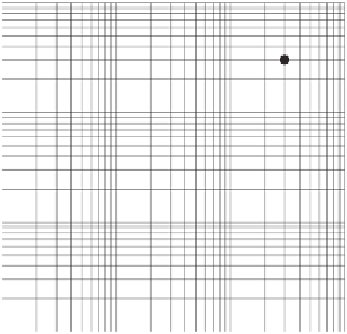Environmental Engineering Reference
In-Depth Information
at least 16 h at 105
◦
C. When the soil specimens are
removed from the oven, immediately place them into
desiccators to prevent the collection of moisture from
the surrounding air.
8. As soon as the soil specimens are cool, measure the mass
of the dry soil and the soil specimen cup. The water
content of each soil specimen can then be calculated.
Table 5.9 Saturated Salt Solutions and Corresponding
Relative Humidity
Salt Solution
Relative Humidity, % Suction, kPa
Lithium chloride
11.3
±
0.3
297,321
Magnesium chloride
32.8
±
0.2
152,517
Potassium iodide
68.9
±
0.3
48,835
Similar steps to those listed above can be followed for the
measurement of the drying branch of the SWCC. However,
in this case, it is important that the initial water content of
the soil be much higher than the final equilibrium state.
The drying and wetting SWCCs are often assumed to be
the same. The results obtained for the drying branch of the
SWCC are generally quite similar to those from the wetting
curve except when the soil is highly plastic. Highly plastic
soils appear to exhibit more hysteresis in the high-suction
range than sand and silt soils (Fredlund, 1964; Ebrahimi-
Birang et al., 2007).
Sodium chloride
75.3
±
0.2
38,738
Potassium chloride
84.3
±
0.3
23,187
Potassium nitrate
93.6
±
0.6
8,635
Potassium sulfate
97.3
±
0.5
3,544
Source
: ASTM E 104-85 (1998) and E 104-02 (2003).
1,000,000
5.12 ESTIMATION OF SWCC
100,000
Unsaturated soil property functions have been developed as
extensions of saturated soil properties. In most situations it
is acceptable to use estimations of unsaturated soil property
functions (e.g., permeability function) when solving unsatu-
rated soil problems in geotechnical engineering (M.D. Fred-
lund et al., 2003). Unsaturated soil property functions play an
important role in the solution of saturated-unsaturated soil sys-
tems. Numerical modeling solutions may not be exact but can
provide a reasonable indication of likely trends. The numer-
ical modeling results provide the geotechnical engineer with
valuable information that assists in decision making.
Let us consider the case of a homogeneous dam where the
engineer desires to know the hydraulic heads in the saturated
and unsaturated soil zones. The selected permeability func-
tion has a reduced effect on the calculated hydraulic heads.
Consequently, much can be learned regarding the behavior
of an engineered structure through the use of approximate
unsaturated soil property functions.
There is one variable that has a reduced dependence on
the soil properties when solving partial differential “field”
equations within a continuum mechanics framework. In the
case of seepage problems, the primary variable that can be
computed is the independent variable called hydraulic head
h
. One of the dependent variables is water flux
q
w
, and
its prediction requires an increased accuracy in the deter-
mination of the permeability function. Consequently, the
accuracy required in the measurement or estimation of the
unsaturated soil property functions depends on the variable
of primary importance for the problem at hand. The same
rationale is true for a stress analysis problem such as the
loading of a foundation footing. The stresses below the foot-
ing are almost independent of the soil properties while the
displacements are highly dependent upon the soil properties.
10,000
1,000
1,000
10,000 100,000 1,000,000
Measured suction using WP4-T, kPa
Figure 5.98
Comparison of theoretical calculated suction and
measured suction (after Ebrahimi-Birang et al., 2007).
5.11.2 Suggested Procedure for Measuring SWCC
using WP4
The following procedure can be used to measure the wetting
SWCC:
1. Measure the mass of the clean stainless steel WP4 soil
specimen cup.
2. Mix an appropriate amount of soil and water to obtain
the desired water content.
3. Seal the sample using a disposable plastic lid that
comes with the apparatus.
4. Perform Steps 1-3 for various water contents.
5. Let the prepared soil specimens equilibrate for at least
16 h.
6. Measure the water potential of each soil specimen and
then immediately measure the mass of the wet soil and
the specimen cup.
7. Place each soil specimen with their lids off in a dry-
ing oven. Leave the soil specimens in the oven for


















Search WWH ::

Custom Search